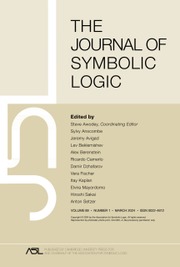Article contents
A Functional calculus of first order based on strict implication
Published online by Cambridge University Press: 12 March 2014
Extract
The following system is an extension of the Lewis calculus S2 to include quantification.
Information
- Type
- Research Article
- Information
- Copyright
- Copyright © Association for Symbolic Logic 1946
References
1 This paper is an extract from a dissertation being written in partial fulfillment of the requirements for the Ph.D. degree in Philosophy at Yale University.
The method for constructing this system was suggested in part by Church's, Alonzo Introduction to mathematical logic, Princeton University Press, 1944.Google Scholar
2 Lewis, and Langford, , Symbolic logic, The Century Co., 1932.Google Scholar
3 See Lewis and Langford, p. 493.
4 McKinsey, J. C. C., Bulletin of the American Mathematical Society, vol. 40 (1934), pp. 425–427.CrossRefGoogle Scholar
5 See Lewis and Langford, p. 125.
6 (∃α) ∼◇∼A ⊰ ∼◇∼(∃α)A follows easily from 40.
7 This Lemma might have been used as an axiom schema in place of 9 and 10.
8 See Lewis and Langford, p. 501.
I am indebted to Professor Frederic B. Fitch for his criticisms and suggestions.
- 131
- Cited by

